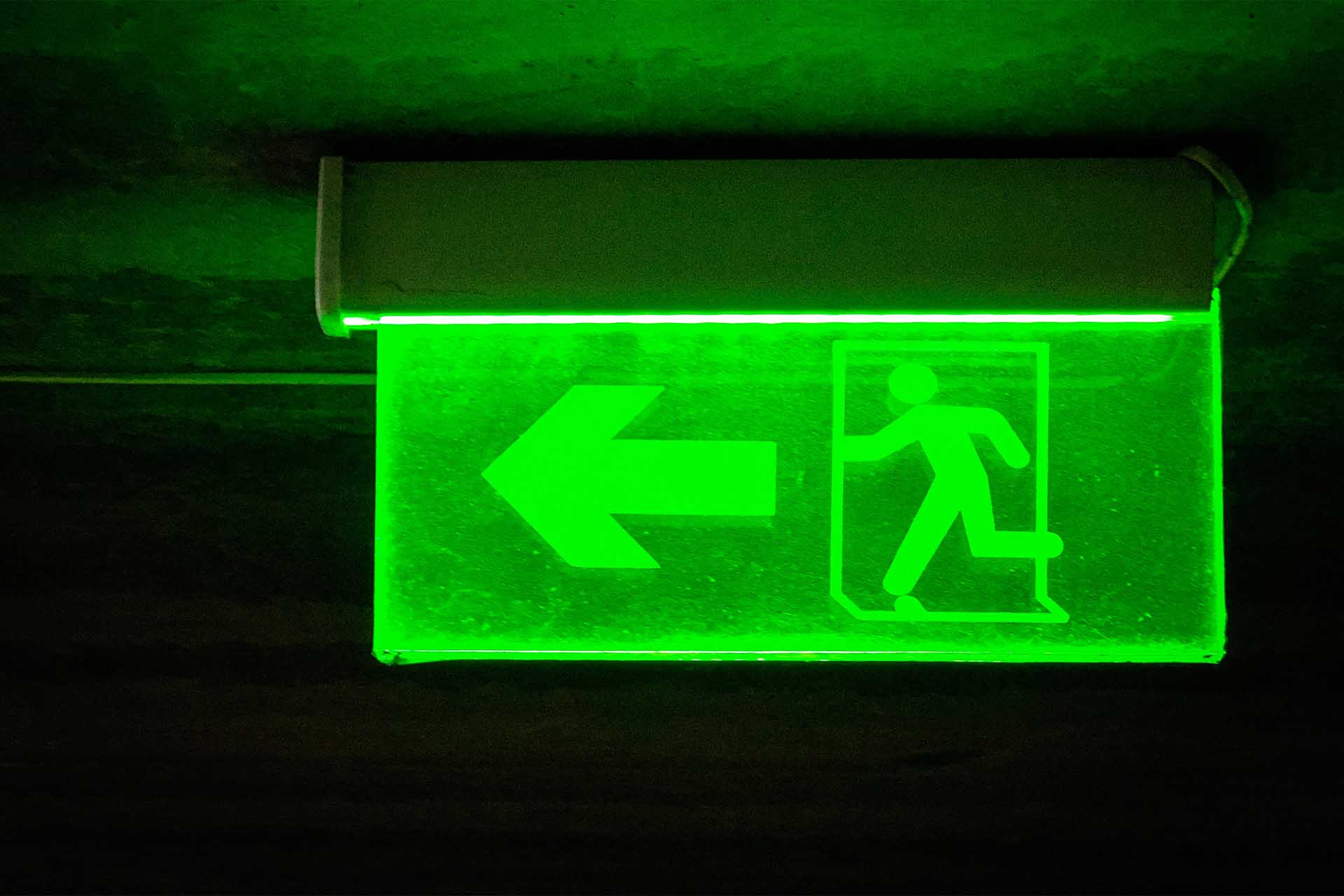Burnout, digitalisation and the hamster wheel
“It’s better to burn out than to fade away. Is it?”
Neil Young sang this line in 1979 – Rock’n Roll forever. It seems to be an expression of strength, maybe as a picture of a successful life, when you go full throttle, going off like a rocket. But burnout is not as heroic as the term sometimes suggests. It is often the result of a loss of control or perception that leads to a forced stop. I like to compare this to a piston seizure in a car: bad maintenance, speedy driving, oil leakage, warning lights ignored, misinterpreted or sealed. Until the car stands smoking at the roadside. Often out of “the joy of driving” or “the desire to reach your destination”, but sometimes also “driven by a pushy driver or lack of time”.
Since 1979, of course, a lot has changed, especially in recent years. Keyword: Digitalisation. The topic of burnout comes into play with the advancing digitalisation at the latest when we do not notice when the use of electronic media costs us too much energy. Facebook, Instagram, Twitter and also the work in the home office are taking their toll. Many of us feel “sucked in”, and this effect virtually fuels “analogue” burnout.
What is burnout?
Many years ago I myself slipped into (analogue) burnout. Whereby I find the term personally inapplicable. The strong state of exhaustion, which hits the body and makes the thoughts turn dark, is actually often closer to a depression with somatic parts. But burnout sounds more heroic. “Man” is burned out because of what he’s done. But it doesn’t have to be that bad.
Another made-up word that came out at some point was “boreout.” I’m “bored to death” in my job because I can and want to do much more than is expected of me. This could be a seasonal or standby job: a security job, a rescue helicopter pilot, an IT helpdesk specialist. These sometimes sit “on standby” for long periods of time and must be “fully available” when the demand comes.1
Burnout and boreout are related to each other for a reason. In both cases, constant resistance to existing conditions leads to exhaustion.
Burnout in itself is not regarded as a disease but as a syndrome.2 Experts primarily associate burnout with the world of work as a reservoir for a whole range of states of exhaustion. Recently, “digital burnout” has also been mentioned repeatedly as a fad. Art terms such as “digital dementia” additionally associate psychopathological terms with digitalisation.
We sometimes burn out because we are enthusiastic about something and because we feel no limits to burning. With so much “flow” and enthusiasm we fly on autopilot into total exhaustion. We do not notice when we are no longer running smoothly and smoothly. Experts warn amateur pilots against “complacency” – a “happy go lucky” self-satisfaction.3 This self-satisfaction leads to simply overlooking approaching dangers like other visual pilots or possible engine problems during one’s own flights.
We also burn out because we deliberately look away. Maybe we have learned a strong performance motive, where we try to be seen or even liked with performance. We hunger for recognition and praise, or think we are irreplaceable. Saying “no” is difficult at the same time. For fear of being rejected or experiencing other disadvantages, some of us keep ourselves permanently available. The result is a lack of (healthy) boundaries and at the same time a feeling of unease.
My burnout – missing purpose
My personal story is like a lion in a golden cage. I was a sought-after specialist for ultra-fast data transmission, the tasks were exciting, I was in full swing. I was regularly thrown a fat steak, I earned well. At the same time I did not feel in the right place in my cage. I lacked the sense in my actions. It was not enough for me to constantly develop even better, even faster microchips, which people could only use to distract themselves from what I think is really important: a joyful, peaceful coexistence and occasionally constructive, appreciative conflict resolution.
Out of fear I avoided escaping from the wide open cage door at that time, because I was worried that I would not be well looked after out there. And so I walked more and more restlessly in circles until I was exhausted. The constant level of stress caused by wanting to be somewhere else than where I was led me into depression: lack of drive, drowsiness, loss of interest in things I had enjoyed before, sleeping beers (anaesthesia, escape), sleep disorders, indigestion, suicidal ideas. My family doctor immediately gave me a sick note for a psychosomatic clinic. The following reconstruction with clinic and psychotherapy was long and expensive, because I could not work properly for a long time.
Keyword: Expensive. I know today that I was not alone. Several million people in Germany are currently suffering from depression.4 Burnout syndrome, however, is diagnosed much less frequently. Not only the health insurance companies complain about the high and expensive sickness rates due to burnout and other mental illnesses, companies also complain about hundreds of euros in costs per day and employee.5 On my way I have met some people who have had a similar fate to mine. Only recently I heard the story of a clerk who was annoyed with her clients almost every day because they submitted their receipts too late or behaved otherwise uncooperative. Through a property that had to be paid for, this woman maneuvered herself into the trap just as I did then.
On my healing path I learned a lot about psychotherapy. I am happy to pass on and apply this knowledge – after thorough, practice-oriented further training. Today, I know how important it is to take countermeasures at an early stage.6 And often I use the metaphor of the car: Who would switch off the warning lights of a car or tape them up until the bulb seizes and causes a lot of damage? Even if we invest a lot of money, it makes much more sense to take your car regularly to the car wash and even to an inspection, to change the oil, to fill up the wiper water and to change the tyres. Your car will thank you for it.
Prevention is cheaper and smarter, but not cool?
Why do we treat our soul, our psychic powers, differently? Why don’t we take precautions and prevent so much damage?
There are several reasons for this:
- The “wear and tear” is often very subtle. We have not learned to recognise our warning lights and it often seems frowned upon or even risky to admit weakness and simply not be efficient for once. If everyday life then seems to be unmanageable, we even take aids to reduce the pressure to perform: alcohol, painkillers, stimulants.
- In addition, our personality development is shaped by evaluation and performance thinking, but we do not all react under the same pressure. Some people are more sensitive, some more robust in the face of “Nothing comes from nothing”, or “mistakes that are painted red”.7 In the past, when we were not allowed to “feel” our feelings and heard sentences such as “You don’t need to be afraid” or “The Indian knows no pain”, and the pain was also “blown away”, this has left its mark. For many, this means feeling “not right” or “out of place” today.
What burnout means for companies
It becomes difficult for companies when bosses feel so responsible that they do not allow themselves any space to feel inside themselves and then make the same taboo for their employees to show weakness. In larger organisations, departments are thus often “driven to wear and tear”, in small companies often even the entire company.
The prominent psychiatrist Dr. Christian Dogs writes in his book “Feelings are not an illness”: In southern Europe, where people live more intensively, with “Passión” and “Caramba”, there are almost no psychosomatic clinics, unlike in controlled living north-western Europe.8 It is obvious to doubt such blanket statements.9 Nevertheless, it is important and helpful to always connect with one’s own needs.10
The iceberg model is very popular in psychoeducation, in teaching about the effects of our psyche. It symbolises that our consciousness, our wanting and striving to control our behaviour only about 10%. We are much more strongly governed by the subconscious, in which many of our experiences since our conception are stored in such a way that they are not directly accessible to us. The unpleasant or unfavorable experiences manifest themselves in the present in stressful patterns of behavior or experience. We keep getting into the same issues inside or outside over and over again. We blame ourselves or others to an unhealthy degree for our misery.
In order not to be helplessly at the mercy of our past, we work in psychotherapy on the current symptoms and find out how more helpful thoughts and behaviour can be learned.11 The step-by-step, regular work – similar to fitness or strength training – leads to the “good things get around in the subconscious” and we feel better in life in the long term.
And what is a “digital” burnout?
A special form of burnout is the “digital burnout”. This is characterised even more by a loss of control due to addiction.12 For example, many families are constantly arguing about the time they use digital media. It is easy to understand why parents in Silicon Valley – who are very familiar with the technology – try to keep their children away from smartphones and other digital devices for as long as possible.13 Apps and social platforms are so cleverly designed and programmed that they make us “addicted” by frequently releasing dopamine. The brain’s reward center is jumping up and down again and again. To the point of total exhaustion. “Normal” sources of well-being become increasingly boring. A few days or hours without a smartphone is like cold turkey. Jesters have even extended the often misunderstood Maslow’s pyramid of needs downwards with “battery” and “WLAN”. FOMO (Fear Of Missing Out) is spreading: The fear of missing something.
How does “first aid” work when it gets too much for me?
They say there is a Buddhist proverb: “Meditate for 30 minutes every day. And if you don’t have time, meditate for 60 minutes.” Mindfulness-based techniques such as MBSR and MBCT have become very popular and also successful in recent years.15 Even with a major search engine provider.15
Mindfulness has been pushed into the “esoteric corner” from time to time. In the meantime, their effectiveness has been sufficiently scientifically proven.16 17
The first aid consists of “Stop! Breathe. Relax actively. Feel. Look closer.”
“Stop!” creates the necessary inner first distance and helps to break the stressful pattern.
“Breathe.” leads from the head into the body. Boxing breathing helps me very well: Count to four when inhaling, then hold (1 – 2 – 3 – 4), exhale (1 – 2 – 3 – 4) and hold (1 – 2 – 3 – 4) etc.
“Relax actively.” is the request to close your eyes and scan your own body. Where is the tension right now? Is it possible to let go of it? Is it possible to “breathe into this spot”?
” Feel.” helps to slowly and finely release the tension and reduce the stress level.
“Look closer.” is an invitation to recognise what is causing the actual stress. What were you thinking just now? What possibilities do you have to relieve the stress? How urgent is the problem?
My tip: Practice interrupting yourself more and more often and asking yourself questions:
- What am I doing here?
- Is that good for me?
- What am I doing it for?
If you can do this on your own, in small steps and at your own pace: Great! Stay tuned. And date yourself!
And if you can’t do it on your own, just get professional help. In America it is now widely understood and accepted to have your own “therapist”. It is a valuable investment in yourself. As natural as the inspection of your car. So your work and private life can be successful over “many hundreds of thousands of kilometers”. At least it should be your responsibility. Towards yourself, your family, your colleagues, your employees. It is worth it. I know that from my own experience.
The myth of the hamster wheel
A little fun fact at the end: When people talk about exhaustion and burnout, the word “hamster wheel” often comes up. If we see a hamster “pedaling” on its hamster wheel, we go into projection. We transfer our inner experience to the hamster. The poor hamster seems to “turn the wheel”, to run “desperately” and not to make any progress. Just as we might feel in everyday life, crammed with tasks and unable to care about real innovation or development.
Do you know that the hamster wheel is a toy for the hamster? Like a swing for human children, which they use cheering? Researchers have actually set up hamster wheels in the wild and noticed that mice, rats and even frogs voluntarily used them.18
Perhaps this fun fact will help you “reframing” your “hamster wheel”. Which aspect of your work can you perhaps look at differently and experience more joyfully? How can you make your job one that you might even love?19
Conclusion
Even though burnout is not an official disease, burnout is a considerable burden for all those affected and their respective environment, which causes significant economic damage. For those affected themselves, for the respective companies and also for our entire society.
The earlier intervention is taken, the better. Just like the maintenance of a car.
Stress that leads to burnout or depression is caused by the fact that those affected suffer permanently from wanting to be somewhere else than where they are at the moment. Mindfulness-based techniques help to reduce or even eliminate this stress.
At the same time, it is important to work on a pattern interruption of harmful thought and behaviour patterns. Here, active relaxation and the reassessment of the situation also helps with regard to sustainability. Also and especially in times of digitalisation.
One last tip: Imagine a miracle would happen and all your problems would disappear overnight. How would you recognise this the next morning? Take this idea as your goal. The path to this goal is neither short nor easy. Just like a fitness training or a muscle building. There is no shortcut. The people who have taken it, however, always report how worthwhile it was to take the new path. Good luck with it!
Notes:
Mario Hauff will be happy to tell you more in an info session and, if necessary, find out with you what an optimal training for prevention or even a therapy against exhaustion or anxiety could look like. Under https://www.angstlotse.de/ you can easily get in contact with him.
Sources in German:
[1] https://www.zeit.de/arbeit/2019-10/bore-out-langeweile-job-unterforderung
[2] https://www.quarks.de/gesellschaft/psychologie/darum-ist-burnout-keine-krankheit/
[3] https://www.flyingmag.com/technique/tip-week/avoiding-complacency/
[4] https://www.deutsche-depressionshilfe.de/depression-infos-und-hilfe/was-ist-eine-depression/haeufigkeit
[5] https://xn--bv-brohund-deb.de/wirtschaftlicher-schaden/wirtschaftlicher-schaden-fuer-unternehmen/
[6] https://www.jku.at/fileadmin/gruppen/112/abgeschlossene_Studien/2013_Volkswirtschaftliche_Analyse_eines_rechtzeitigen_Erkennens_von_Burnout.pdf
[7] https://de.wikipedia.org/wiki/Diathese-Stress-Modell
[8] https://www.psychologie-heute.de/leben/artikel-detailansicht/39614-die-abwehr-aufgeben.html
[9] https://www.spektrum.de/rezension/buchkritik-zu-gefuehle-sind-keine-krankheit/1552148
[10] „Was deine Wut dir sagen will: überraschende Einsichten“, Marshal B. Rosenberg 08/2013
[11] https://www.klaus-grawe-institut.ch/blog/problemaktualisierung/
[12] https://www.arte.tv/de/videos/RC-017841/dopamin/
[13] https://www.independent.co.uk/tech/bill-gates-and-steve-jobs-raised-their-kids-techfree-and-it-should-ve-been-a-red-flag-a8017136.html
[14] Mindfulness Based Stress Reduction / Mindfulness Based Cognitive Therapy
[15] https://www.youtube.com/watch?v=r8fcqrNO7so
[16] https://www.haufe.de/arbeitsschutz/gesundheit-umwelt/achtsamkeit-wirkung-wissenschaftlich-belegt_94_280626.html
[17] https://www.zeit.de/zeit-wissen/2012/01/Meditation-auf-Rezept/seite-2
[18] https://www.spiegel.de/wissenschaft/natur/tiere-in-bewegung-wilde-maeuse-und-froesche-laufen-im-hamsterrad-a-970575.html
[19] https://hbr.org/2010/06/managing-yourself-turn-the-job-you-have-into-the-job-you-want
Mario Hauff has published more articles here in the t2informatik Blog:

Mario Hauff
Dipl.-Ing. Mario Hauff is the Angslotse. He guides individuals and organisations through difficult phases aggravated by fear and uncovers their potential with them. Like a nautical pilot he goes “on board” until “safe waters” are reached again and imparts self-efficacy and self-empowerment. After 20 years as an electrical engineer for microelectronics in an American company, he now offers individual and group coaching sessions, workshops and keynote lectures on growth in safety with state-of-the-art, scientifically sound findings.
“Why it works without fear”: You may stand at a canyon or in front of the photo wallpaper of a canyon.


